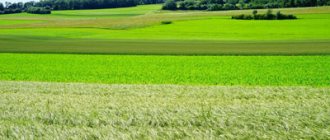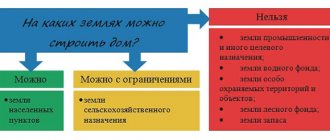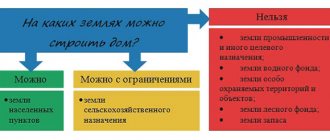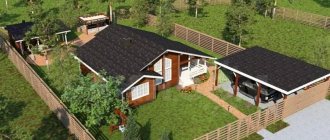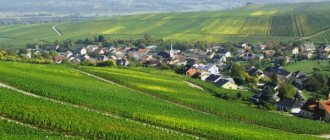All human life activities are directly or indirectly connected with the earth, since we:
- we cultivate the land to obtain the necessary food products,
- we build houses on the ground,
- We use forest and water.
One of the basic needs of people is to have housing .
In Russia, the use of land plots is regulated by land legislation.
According to the Land Code, residential construction is carried out on a special type of territory. The name of this category of land is land of settlements.
They are not the most common (extended in area) category, but they are home to the majority of the population of our country.
What it is?
Land legislation provides for seven categories into which plots of land can be divided. This document gives the concept of lands belonging to settlements. It is indicated that such plots are those that do not extend beyond the boundaries of the populated area.
The purpose of such lands is to develop infrastructure and carry out construction work. The types of permitted land use are specified in a specially developed classifier. The boundaries of territories are indicated in legislative acts. Some subjects have the authority to change them.
The concept of NP lands
These include:
- bodies carrying out government activities at the federal level;
- local authority;
- judicial authorities.
conclusions
Lands of populated areas are the central category of lands, since they form the basis of human life .
Today, when almost the entire population of the state is concentrated in the ZNP, the question of the rational use of the available limited areas is of particular importance.
First of all, this concerns compliance with legislative regulations - urban planning regulations, VRI, as well as the inevitability of applying sanctions for violations.
Since land is a non-renewable resource, the following are also important:
- compliance with the principles of land protection,
- implementation of safe land use,
- causing minimal damage to the natural environment,
- compensation for damage caused.
Composition and zoning
The urban planning documentation, which is established for each region, prescribes the composition of lands related to settlements. The composition includes the following groups of territories related to zones:
- zones of location of buildings intended for residence;
- territories with industrial purposes;
- lands intended for the location of transport schemes and engineering;
Land composition - agricultural land;
- recreational allotments;
- territories with special purposes;
- lands intended for the construction of objects with military purposes.
Rules regarding land use and development are prescribed in urban planning acts, which are provided for each type of territory individually. In this case, the nuances regarding the development and location of plots must be taken into account, and their capabilities in relation to the combination of different types of use of plots are also important.
If the land is located in a residential area, then only residential buildings can be erected on it; objects with domestic, cultural and other purposes can also be located.
When it comes to the lands of the public and business zone, its purpose is the construction of administrative buildings, objects that have social, educational, social, domestic and other meanings. Industrial zones are subject to development with production and other facilities that can be built in accordance with legislative acts.
Kinds
The permitted use for the category of land in question is established in a special classifier. All plots related to settlements can be conditionally divided into zones by territory.
Indicate areas such as:
- location of residential buildings;
- buildings of a public and business nature;
- for conducting business activities;
- use for public purposes;
- organization of recreation.
Legal regime of lands
The above zones include several types of use. Including:
- Residential areas include those uses that involve the construction of residential buildings. According to the classifier, they include:
- houses built like townhouses (blocked type);
- high number of storeys includes the construction of buildings above 8 floors;
- average number of storeys – up to 8.
tent cities – this means a mobile variety;
Individual residential buildings, for example, cottages, private houses, etc., can also be built. In addition, the construction of buildings for domestic purposes, such as a garage and utility room, is allowed. The possibility of running a personal subsidiary plot with the construction of a private house for this purpose is provided. In this case, a person must have a main goal - growing a vegetable garden, orchard or livestock.
Signs of NNP
https://www.youtube.com/watch?v=lC8tOufJhFY
What categories are there?
In addition to the category of “land of settlements”, there are others, which are designated depending on the permissible activities on the land. Obviously, the site cannot be used in parallel :
- for growing forests,
- railway laying,
- wheat growing,
- construction of a multi-storey residential complex.
There is a legislative division of land categories in order to:
- to delimit the possibilities of land use,
- minimize harmful consequences,
- provide the necessary procedures for the protection and renewal of land.
more about the different categories of land here.
- Agricultural land is the most valuable. These fertile areas are intended for cultivating crops and raising livestock. First of all, they are allocated for farming, and the rest - for other purposes.
- water fund lands - the bottom of reservoirs and lands occupied by technical and other water-related structures.
- reserve lands - empty lands on the territory of the state, the use of which requires a change in category.
All ways to find out the category of a land plot are described here. The simplest of them is by cadastral number.
Private household plots
On plots that are allocated for personal subsidiary farming, the construction of residential buildings is allowed. Rules are established regarding their number of floors - no more than three. In this situation, garages and utility rooms are also not subject to accounting. Particular emphasis is placed on the fact that the house can only be single-family.
On the site having the intended purpose, livestock breeding, gardening and gardening are allowed.
https://www.youtube.com/watch?v=GMNS_jNofj0
The attention of the land user is drawn to the fact that subsidiary farming in relation to agricultural lands and lands related to settlements are completely different and have different permitted uses.
In the latter case, the construction of houses can be carried out without restrictions, but in another situation, discussed above, approval is required from the commission involved in land use activities. A requirement is also established that the allotment must be used on an ongoing basis in accordance with its intended purpose and must be processed.
Land law
Many businessmen who have a desire to open industrial production on their plots ask questions: if there are private household plots and individual housing construction lands, what is the difference between them in terms of re-registration, because production cannot simply be organized on agricultural lands? If it is necessary to change the status of a land plot, it does not matter what abbreviation your plot bears. The lion's share of the success of this event will depend on the quality and value of the land in question.
What is the difference between individual housing construction and private household plots and DNP or SNT plots in terms of taxation? Tax accruals for individual housing construction and dacha non-profit partnerships are formed based on the cadastral value and the tax rate (individual housing construction has a higher tax rate), accordingly, the owner of individual housing construction will pay more to the treasury. But the owner of a DNP or SNT can build a house himself, without any approval.
Blocked residential building
When we talk about construction of this type, we talk about the possibility of building several houses that will be single-family. It is indicated that the buildings are adjacent to each other.
Requirements are established regarding the number of storeys - as in the situations discussed above, it cannot exceed the value of 3. Premises with utility purposes and garages are not subject to accounting. It is allowed to plant vegetable gardens, orchards, and flower beds on the site.
Composition and characteristics of NP lands
The concept of the structure in question is provided for at the legislative level. An indication is made that the structure must consist of several parts, the maximum is set at 10. It is also stipulated that each of the parts must be provided with a separate exit to the territory, which belongs to the common one.
Land in populated areas for gardening and agricultural use
The components of each category of land plots are lands that have different uses that are permitted for them. When use occurs contrary to established norms, the punishment prescribed by law is applied to violators. The legislator provides rules according to which the allocation of territories for gardening or horticulture is carried out.
The difference between the types of plots under consideration is the permitted use regarding the cultivation of agricultural products on them, as well as the type of buildings that can be erected.
Land for agricultural use as part of the ZNP
A garden plot means an allotment intended for growing vegetables, berries and other fruits. On such territory it is allowed to erect buildings with economic and residential purposes.
It is possible to live in them for 12 months. In this case, a ban on registration actions is established. The plots in question may have private owners as owners, or they may be subject to a lease agreement.
Gardening and vegetable gardening activities cannot be classified as entrepreneurial, which means using the harvest for personal purposes. The laws provide for a maximum size for allotments.
The functions of allocating land for the intended purpose are assigned to municipal authorities. The procedure for extradition is prescribed by law. The order is fixed by the administration. In 2015, adjustments were made to the classifier; to find out what type of buildings are allowed to be erected on the site, you must refer to the specified act.
The types of plots under consideration, including DNT and DNP, can be issued on the basis of perpetual use rights. This provision is carried out by the local administration. If the plot is on this basis, then the citizen can count on receiving ownership of it. This will require a privatization procedure.
https://www.youtube.com/watch?v=l-wQFQDozo4
When the plots are used by partnerships that have a non-commercial orientation, then they are subject to the ownership rights of the federation or region. Land allocated for gardening can be used for the purpose of erecting buildings of capital importance. If we are talking about gardening, then only temporary buildings are allowed.
According to amendments made to legislative acts in 2021, real estate located on garden plots must have technical documentation.
PRO new building 7 (499) 450-27-46 (Moscow)
- The state can buy and seize for its own benefit objects that belong to legal or private entities, or are leased.
- Individuals or legal entities must obtain ownership of the areas along which the border runs. Such properties are allowed to be rented out.
- The territorial border can only be changed by issuing the corresponding law of the Russian Federation. Once the lands are included in the settlement, individuals and legal entities should not lose ownership of them.
- All land owners and occupiers must take into account the rules specified in the building regulations. The main thing is that the land is used strictly for its intended purpose.
- Only subjects of the Russian Federation can change the size of territories along with legal norms.
- The consent of parents or guardians is required if a plot previously owned by a minor is purchased.
- There may be discrepancies in the papers regarding such parameters as dimensions and parameters, description of the site.
- You should not take a plot for which the state already has ownership rights. Or who has been arrested.
- It is worth looking at how well the data in the contract corresponds to the real state of affairs.
Urban zoning
This procedure is carried out through the adoption of rules relating to land use and territory development. With its help, the basic regulation of activities of an urban planning nature is supplemented and developed. With the help of the rules established regarding the use of plots and their development, a connection is made between the following documentation:
- layout and territorial planning;
- there is a regulatory impact on persons who have rights regarding various real estate objects located on the territory.
Map of the planned functional zoning
Thanks to the zoning of space, the site is divided into different zones, in relation to which boundaries are established. Each of the plots has its own separate legal status. It is also possible to establish some restrictions regarding the use of land.
When preparing rules regarding the use of plots and construction within territorial zones, the following must be taken into account:
- the ability to combine several types of permitted use within one territory;
- the functionality of the zones and the parameters established in relation to the direction that is planned to be applied are taken into account;
An example of an urban planning plan for a land plot - planning and use zones enshrined in legislation;
- changes that will be made to the allotment are also taken into account;
- the possibility of causing damage to objects of capital importance, which are located on adjacent plots, is taken into account.
Regarding the lines of territorial zones, it is established that they pass:
- along the lines highlighted in red;
- lines related to streets, highways, driveways, etc.;
- plot boundaries;
- municipal boundaries;
- other.
When establishing town planning regulations, the following are taken into account:
- actual use of the territory and construction sites;
- combination of different types of use on one plot;
- allotment functionality;
- types of territoriality zones;
- protection of objects related to cultural heritage.
Urban planning documentation applies to land and construction sites located in the same zone.
